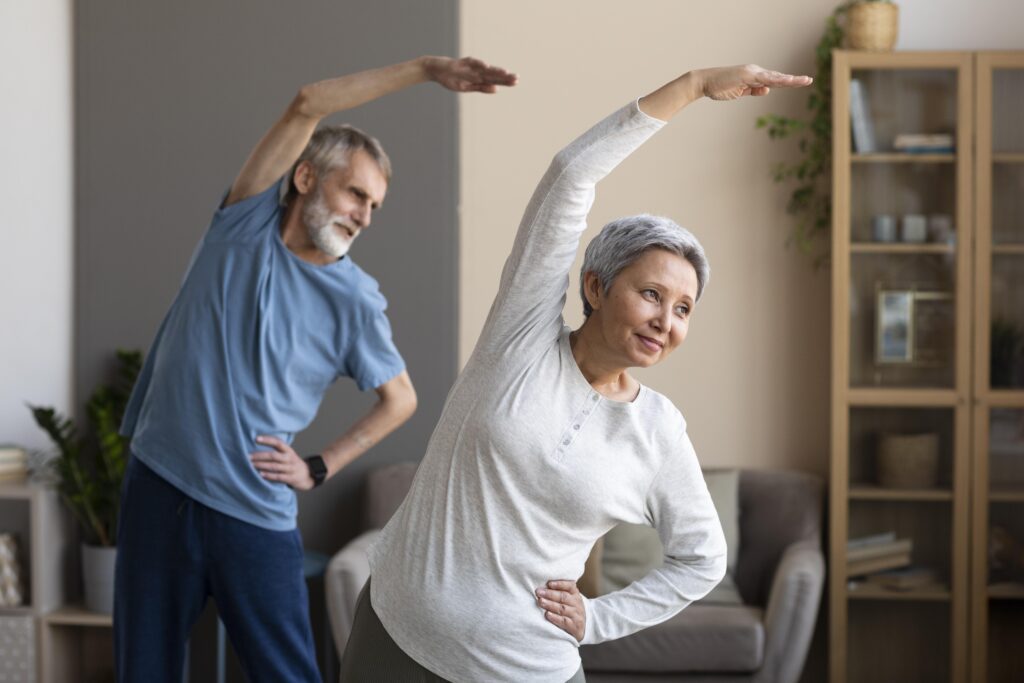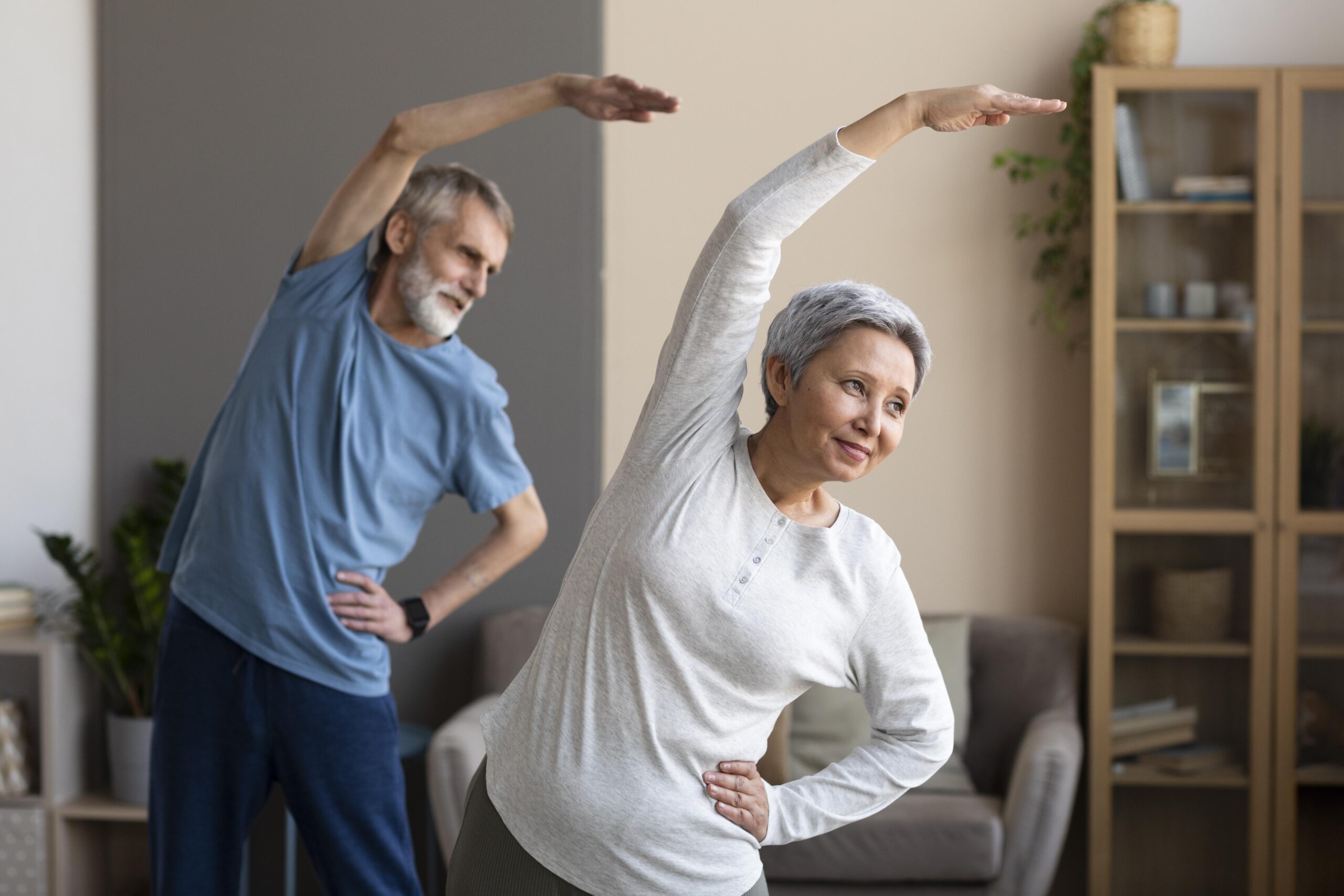Physical activity is essential for seniors to maintain good mental health and prevent chronic diseases. It also plays a pivotal role in maintaining and improving mental health. It's not just about building muscle or losing weight; it's also about taking care of your mind. However, it is crucial to choose exercises that are safe and suitable for their age and physical condition. In this article, we will discuss the types of exercises that are beneficial for seniors, the seven best exercises for seniors, and exercises to avoid.
Flexibility and balance exercises are important for older adults with diabetes. Stretching improves joint mobility and flexibility, while balance training reduces fall risk, even with peripheral neuropathy. Group exercise interventions, such as resistance and balance training or tai chi classes, may decrease falls by approximately 28% to 29%. Yoga and tai chi show potential benefits for glycemic control and overall well-being in adults with diabetes, although more research is needed for conclusive evidence.
To meet the physical activity guidelines, adults aged 65 and older should engage in the following:
- Moderate-Intensity Activity: At least 150 minutes per week, which can be achieved through 30 minutes of moderate-intensity activity daily for 5 days a week. Examples include brisk walking, cycling, or swimming.
- Vigorous-Intensity Activity: Alternatively, they can opt for 75 minutes per week of vigorous-intensity activity, such as hiking, jogging, or running. This can be spread across the week in sessions of at least 10 minutes each.
- Muscle-Strengthening Activities: Engage in muscle-strengthening activities at least 2 days a week. This can involve exercises like weightlifting, resistance band workouts, or using weight machines.
- Balance Improvement: Incorporate activities to improve balance, such as standing on one foot, practicing tai chi, or participating in yoga. These exercises help enhance stability and reduce the risk of falls.
We will also provide safety tips for seniors to follow when exercising, such as consulting a doctor before starting any exercise program, using proper equipment and gear, and listening to their body to avoid pain or discomfort. By following these guidelines, seniors can enjoy the benefits of regular exercise while reducing the risk of injury or strain.
Types of Exercises for Seniors
In the quest for fitness and health during our golden years, understanding the different types of exercises for seniors is essential. The main categories of exercises include endurance, strength training, balance exercises, and flexibility exercises.
- Endurance exercises: Endurance exercises, also known as aerobic exercises, are activities that increase your heart rate and breathing for an extended period. These exercises are beneficial for seniors as they improve cardiovascular health, increase endurance, and reduce the risk of chronic diseases such as diabetes, heart disease, and stroke.
- Strength training exercises: Strength training exercises, also known as resistance exercises, involve using weights or resistance bands to strengthen muscles. These exercises are beneficial for seniors as they help maintain muscle mass, increase bone density, and improve balance and posture.
- Balance exercises: Balance exercises help seniors maintain their balance and prevent falls, which are a significant risk for seniors. These exercises improve stability, coordination, and posture. Some of the balance exercises that are suitable for seniors include: standing on one foot, heel-to-toe walk, using a stability ball.
- Flexibility exercises: Flexibility exercises involve stretching muscles and joints to improve range of motion and reduce stiffness. These exercises are beneficial for seniors as they increase mobility, reduce the risk of injury, and improve posture. Some of the flexibility exercises that are suitable for seniors include: stretching exercises such as shoulder and hamstring stretches, pilates, chair exercises.

7 Best Exercises for Seniors
Staying active is integral to a healthy and fulfilling senior lifestyle, but knowing which exercises are most beneficial can be challenging. The best exercises for seniors are those that balance safety, effectiveness, and enjoyment, while targeting key areas such as strength, flexibility, balance, and aerobic fitness.
- Walking is one of the easiest and most accessible exercises for seniors. It is a low-impact exercise that can be done indoors or outdoors, and it can be done alone or with a group. Walking is an excellent way to improve cardiovascular health, increase endurance, and maintain a healthy weight. Regular walking has been shown to significantly reduce the risk of physical disability among elderly adults, enabling them to maintain their independence and continue living in their own homes. A study conducted in 2008 at the University of Georgia revealed that engaging in regular walks decreased the likelihood of developing a physical disability by 41%. This highlights the importance of walking as a simple yet effective activity that supports healthy aging and allows seniors to age in place.
- Water aerobics is a low-impact exercise that is perfect for seniors with joint pain or mobility issues. It is an excellent way to increase strength, endurance, and flexibility without putting stress on the joints. Water aerobics can be done in a shallow or deep pool, and it is a fun and social way to exercise.
- Cycling is a low-impact exercise that can be done indoors or outdoors, and it is an excellent way to improve cardiovascular health, increase endurance, and strengthen leg muscles. Cycling can be done on a stationary bike or a regular bike, and it can be done alone or with a group.
- Yoga is an excellent exercise for seniors as it can improve balance, flexibility, strength, and reduce stress levels. Yoga poses can be modified for seniors with mobility issues, and it can be done in a class or at home. Chair yoga is an excellent option for seniors with limited mobility.
- Resistance band exercises are an excellent way to increase strength and flexibility without using weights. Resistance bands come in different levels of resistance, making it easy to customize the exercise to the individual's needs. Resistance band exercises can be done at home or in a class.
- Chair Yoga is a modified form of yoga that can be done in a chair or with the support of a chair. It is an excellent option for seniors with limited mobility or balance issues. Chair yoga can improve flexibility, strength, and reduce stress levels.
- Tai Chi is a low-impact exercise that involves slow and gentle movements that improve balance, flexibility, and coordination. Tai Chi is an excellent option for seniors who want to improve their overall well-being and reduce stress levels.
Exercises to Avoid for Seniors
While regular exercise is beneficial for seniors, there are certain types of exercises that may pose risks or be inappropriate for older individuals. It's important for seniors to be mindful of their limitations and avoid exercises that may put excessive strain on their bodies. Here are some exercises to avoid for seniors:
- High-impact exercises։ High-impact exercises such as running, jumping, or aerobics can put a lot of stress on the joints, which can be harmful to seniors, especially those with arthritis or other joint issues. These exercises can cause joint pain or even injuries such as fractures. Low-impact exercises such as walking or water aerobics are better options for seniors.
- Exercises that require a lot of bending or twisting։ Exercises that require a lot of bending or twisting can put a strain on the lower back and increase the risk of injury. Examples of such exercises include sit-ups or toe-touches. Seniors can modify these exercises by performing them on a stability ball or using a chair for support.
- Exercises that require a lot of jumping։ Jumping exercises such as jumping jacks or plyometrics can be too intense for seniors and can increase the risk of injury, especially if they have balance issues. Low-impact alternatives such as step-ups or leg lifts are better options for seniors.
- Exercises that require quick and sudden movements։ Exercises that require quick and sudden movements such as kickboxing or martial arts can be too intense for seniors and increase the risk of injury. These exercises require good coordination and balance, which may be challenging for seniors. Low-impact exercises such as yoga or tai chi are better options for seniors.
Safety Tips for Seniors
When it comes to maintaining an active lifestyle in our later years, safety is paramount. Here's a concise overview of essential safety tips for seniors:
- Consult a doctor before starting any exercise program: Before starting any new exercise program, seniors should consult with a healthcare professional. A doctor can assess their physical condition and recommend exercises that are safe and suitable for them.
- Warm-up and cool down before and after exercising: Seniors should always warm up before exercising to prepare their muscles and joints for the workout. This can include light stretching or walking. Similarly, seniors should cool down after exercising to gradually lower their heart rate and prevent muscle soreness.
- Use proper equipment and gear: Seniors should use proper equipment and gear when exercising to prevent injuries. This includes wearing comfortable and supportive shoes, using a mat for floor exercises, and wearing protective gear such as helmets for cycling.
- Start slow and gradually increase the intensity of the workout: Seniors should start with low-intensity exercises and gradually increase the intensity of the workout over time. This allows their body to adjust to the exercise and reduces the risk of injury or strain.
- Listen to your body and stop if you feel pain or discomfort: Seniors should listen to their body when exercising and stop if they feel pain or discomfort. Pushing through pain can lead to injuries or exacerbate existing conditions. Seniors should always modify exercises as necessary to avoid pain or discomfort.
Regular physical activity is important for seniors to maintain good health and reduce the risk of chronic diseases. However, it is essential to choose exercises that are safe and suitable for their age and physical condition. Endurance exercises, strength training exercises, balance exercises, and flexibility exercises are beneficial for seniors, while high-impact exercises, exercises that require a lot of bending or twisting, exercises that require a lot of jumping, and exercises that require quick and sudden movements should be avoided.
Seniors should also follow safety tips when exercising, such as consulting a doctor before starting any exercise program, warming up and cooling down, using proper equipment and gear, starting slow and gradually increasing intensity, and listening to their body to avoid pain or discomfort. By following these guidelines, seniors can enjoy the benefits of regular exercise and improve their overall well-being.





